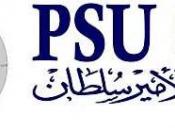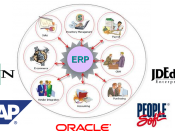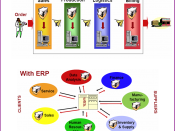�� SHAPE \* MERGEFORMAT ����
�
�
�
31. What is ERP �
42. Main Modules ERP �
42.1. Inventory Management System �
52.2. Customer Relationship Management (CRM) �
52.3. Supplier Relationship Management �
52.4. Production Management �
62.5. Sale Management �
62.6. Human Resource Management �
72.7. Finance Management and Accounting �
73. Company needs an ERP System �
73.1. Goals of Implementing an ERP System �
84. ERP in the New Management Practices �
95. ERP Systems Architecture �
106. Commercial ERP Systems �
106.1. SAP �
11 6.1.1. SAP Business ByDesign �
12 6.1.2. SAP Business Suite �
15 6.1.3. SAP Business One �
15 6.1.4. SAP All-in-One �
166.2. Bann Corporation-Flagship Product iBaanERP �
16 6.2.1. iBaan ERPModules �
166.3. Oracle Corporation-Flagship Product Oracle Applications �
17 6.3.1. Oracle E-Business Suite �
19 6.3.2. PeopleSoft Enterprise �
21 6.3.3. J.D. Edwards EnterpriseOne �
247. ERP Implementation Life Cycle �
258. Advantages of ERP �
259. Disadvantages of ERP �
2710. References: �
��
What is ERP
ERP stands for enterprise resource planning.
It usually refers to the methodology used to perform back office functions that are transparent to customers.
ERP is often implemented in companies together with process-oriented organization or Supply Chain Management (SCM). In order to manage the information-flow of such structures new IT-systems are generated - known as ERP-Systems. IT-systems of this kind allow managers from all departments to look vertically and horizontally across the organization to see what others are accomplishing or not. It attempts to integrate all departments and functions across a company onto a single computer system that can serve all those different department's particular needs. ERP-systems also implement and automate business processes, putting them into a useful format that...


